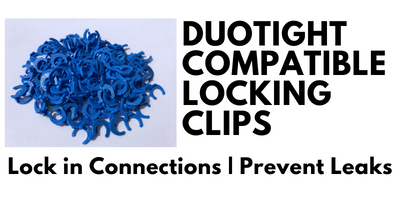
Kegerator Tubing – Barbed vs Flare Fittings – what should you use?
 Pictured: YaeBrew Gas Manifold, Beer Gas Distributor, Air Distributor CO2 Manifold – Splitter 5/16″ Barb Fittings (4 Way)
Pictured: YaeBrew Gas Manifold, Beer Gas Distributor, Air Distributor CO2 Manifold – Splitter 5/16″ Barb Fittings (4 Way)
I think that the general consensus among homebrewers and home kegerator builders is that… MFL/Flare/Swivel connections are superior to barbed connections. That’s just my read on the situation, no scientific basis for that statement. After all, MFL swivel thingies look cool, they’re easy to attach and you can take tubing on and off easily and. The total solution, including swivels also generally costs more… more expensive = more better… right?
My take on the matter…
For gas lines: Personally, I prefer barb fittings on CO2 lines as they don’t loosen over time. Use a quality clamp and you have a solid connection that should not loosen or leak over time. Moving kegs and lines around could conceivably loosen MFL connections and a CO2 leak is invisible. Even a small, slow leak could equal an emptied CO2 tank.
For liquid lines: A liquid leak is a lot more obvious. A little dripping from a liquid MFL line would tell you that the line has loosened. I generally use flare swivels on liquid lines. I do still use barbs on tail pieces because that’s kind of a tight spot on my kegerator that makes it difficult to turn a wrench.
Of course you can use whatever you want. If you use MFL, I suggest periodically tightening swivels to make sure you always have a good, solid connection.
Or… DuoTight!
Kegland’s DuoTight Fittings are designed to work with EVABarrier Double Wall Tubing. They offer quick, reliable connections, easy implementation, a variety of fitting options and feature amazing versatility. They’re also, generally speaking, very well priced. DuoTights are push to connect fittings and require no tubing clamps.
DuoTights are… awesome. Check out my extensive Hands on Review
As it relates to leaks, I do recommend using these with DuoTights. Those really help to lock in connections.
Related DuoTight Reviews on How-To’s!
Buy DuoTight
- DuoTight Push In Fittings & EVABarrier Double Wall Draft Tubing at MoreBeer
- Search MoreBeer for “DuoTight” – to find components and accessories that may not show up on category pages.
- Kegland DuoTight Fittings and Accessories at William’s Brewing
- Search William’s Brewing for “DuoTight” – to find components and accessories that may not show up on category pages.
- Search Amazon for “DuoTight” – offerings vary
- Search Amazon for “EVABarrier Tubing” – offerings vary
- DuoTight Compatible Locking Clips via Valuebrew
I Recommend These for DuoTight Fittings!
Also: Kegerator Tips & Gear | Keg Repair Part #s | Recent Keg Finds
Our Top Draft Resources!
Check our our Top Draft Related Resources- Commentary: Pin Lock Keg Pricing and Availability
- Check Your CO2 Regulator for Leaks!
- How to get a keg ready for first use? New Keg Cleaning and Prep
- Portable Draft Beer Serving Options!
- Pin Lock Keg Pricing and Availability
- The Most Difficult Spot to Check for CO2 Leaks
- Keg O-Ring Materials Selection! – EPDM, Silicone and Buna-N?
- Why Do I Have Bubbles in My Beer Line? Diagnosing and Fixing Kegerator Foam Problems
- Five Benefits of Using Corny Kegs As Fermenters
- Rebuilding & Reconditioning Homebrew Kegs!
- Food Safe Replacement Keg O-Rings in Bulk
- Hands on Review: Kegland DuoTight Fittings & EVABarrier Tubing!
- Why Won’t My Beer Carbonate? Fixing Draft Beer Carbonation Problems
- What Does a Flow Control Faucet Do?
- Upgrade Your Kegerator – 6 Improvements!
- Serve Homebrew on Any Kegerator & Convert Commercial Kegerator to Homebrew
- Tips and Gear for Growler Filling
- What’s the Difference Between Ball Lock Kegs and Pin Lock Kegs?
- Checking for Draft System CO2 Leaks – Using The Pressure Gauge Method
- Tip: Consider Oetiker Stepless Clamps for Kegerator Gas and Beer Lines
- Hands On Review: Inkbird ITC-308 Dual Stage Temperature Controller +WiFi Version
- Universal Poppets Tips and Tricks!
- Convert Your Mark II Keg & Carboy Washer to a Recirculating Draft Line Cleaning Pump!
- Step by Step: Finding and Fixing Keg CO2 Leaks
- Kegerator Temperature Probe Placement – To Immerse or Not To Immerse? – three tests to determine optimal pla…
- Kegerator Beer Line Temperatures & Reducing Foam with a Recirculating Fan
- Kegging CO2 Use Estimations and Calculations
- Balancing Your Kegerator Draft System
- Building a Simple Ball Lock Draft Line Flushing Setup
- Build a Recirculating Draft Line Cleaning Pump
- Home Brew Keg Roundup – New & Used, 5 and 2.5 Gallon & More!
- Damp Kegerator? Fix Kegerator Condensation
- Homebrew Temp Controller Roundup! – Kegerator and Fermentation – concepts, applications and models
- Bulk Keg Orings and Keg Parts Reference
More Homebrew Finds!
- Last 50 Finds!
- Top Deals – a curated list of the best deals
- Homebrew Reviews – one of the largest libraries of homebrew reviews in existence!
- Our Top Posts – tips, how-tos, resources posts and more
- Let’s be Friends!
Recent Deals!
10 Most Recent Homebrew Resource Posts & How-To’s!
We are Homebrew Review HQ! Our 10 Most Recent Reviews
pinnedThis post may contain affiliate links. We may make a commission when you use our links. This will never cost you extra. Thank you for supporting Homebrew Finds!
greatdealsPrice, promotions and availability can change quickly. Check the product page for current price, description and availability. tag:lnksfxd toppost:flarevsbarb tag:tpr




